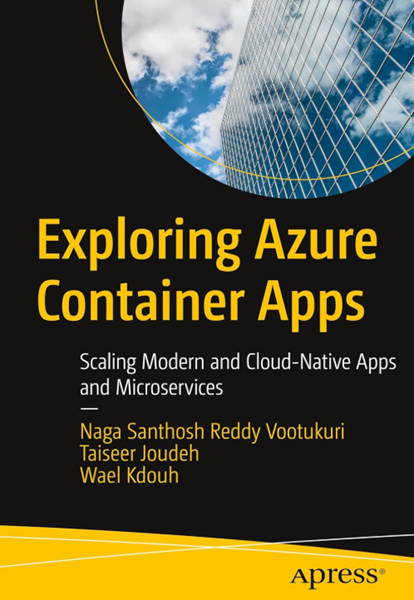Book Review: Exploring Azure Container Apps

I was recently sent an interesting book to review Exploring Azure Container Apps - Scaling Modern and Cloud-Native Apps and Microservices by Naga Santhosh Reddy Vootukuri, Taiseer Joudeh, and Wael Kdouh. I’ve been reading it over the last week while traveling.
Content
If you’ve been keeping an eye on Microsoft’s container story lately, you’ve probably noticed Azure Container Apps (ACA) gaining serious traction. It’s that just right service that sits between the Azure App Service and the full complexity of Kubernetes—managed. My work with it have found it to be flexible, and surprisingly capable once you dig in.
This book is one of the clearer, more practical guides I’ve seen for anyone wanting to understand how ACA actually works in real-world deployments.
A gentle start with strong foundations
The book starts by explaining what Azure Container Apps are, how they differ from Kubernetes and App Service, and why you might choose them. It does a nice job of setting the context without drowning you in theory. From there, it moves straight into setting up Azure Container Registry (ACR) — showing how to store and manage your container images securely, with tips on access control and best practices that save you time later.
Even if you’ve worked with ACR before, these early chapters are a good refresher. They’re practical, clear, and set you up nicely for the later, more complex topics.
Scaling, deploying, and troubleshooting
Once you’re past the basics, the book dives into deployment patterns and scaling with KEDA (Kubernetes Event-Driven Autoscaler). This section stood out to me because it doesn’t just show how to scale apps — it explains why you’d pick one scaling trigger over another, and how to tune them for your workload. The troubleshooting guidance is also solid, with examples that mirror the kind of issues you’ll actually hit in production.
Dapr integration
For me, the strongest part of the book was the part on Dapr (Distributed Application Runtime). I hear people describe Dapr as a bit mysterious at times, but this book explains it clearly and shows exactly how it plugs into Azure Container Apps. You get hands-on examples of using Dapr’s building blocks — pub/sub messaging, state management, bindings — and how those pieces simplify communication between microservices. It’s one of those sections where you start to see how ACA and Dapr together can replace a lot of boilerplate code.
Jobs, monitoring, and real-world concerns
Later chapters cover things that are often skipped in cloud-native books — background jobs, state management, and monitoring with Application Insights. These sections make the book feel practical rather than purely conceptual. It’s clear the authors understand how teams actually run apps in production and the need for observability and reliability.
The discussion around microservice communication patterns is also helpful — showing how to design clean service boundaries and handle internal traffic inside your ACA environment.
Summary
All up, this is a practical, well-structured guide for developers and architects who want to use ACA confidently. It doesn’t assume deep Kubernetes experience, so it’s approachable if you’re coming from an App Service or Azure Functions background.
If you already know Kubernetes inside out, you might skim through the early sections — but the Dapr integration and scaling examples alone make it worth your time.
For anyone looking to modernize their deployments without diving head-first into full-blown AKS complexity, this book is an excellent companion.
8 out of 10
2025-10-16
